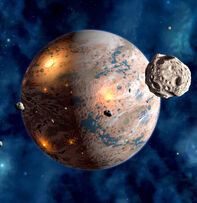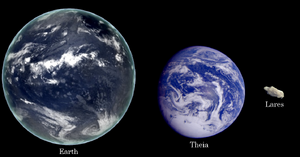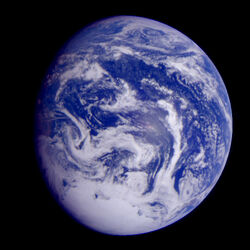| Theia | |
|---|---|
| Alternate names | Thia, Eurys |
| Aphelion | 192,173,669 km |
| Perihelion | 187,304,274 km |
| Semi-major axis | 189,738,971 km |
| Eccentricity | 0.02566381 |
| Orbital period | 521.6169942 days |
| Satellites | 1 (Lares) |
| Mean radius | 4,038.0 km |
| Equatorial radius | 4,042.0 km |
| Polar radius | 4,033.0 km |
| Circumference | 25,371.502 km |
| Surface area | 204,900,252 km2 |
| Volume | 275,795,739,643 km3 |
| Minimum | -98.5°C |
| Median | 11°C |
| Maximum | 49°C |
| Nitrogen | 74.4% |
| Oxygen | 23.7% |
| Carbon dioxide | 0.092% |
| Argon | 0.024% |
are presented from the perspective of our universe | |
Theia is the fourth planet from the sun, the second densest, and the seventh largest of all the planets in the Solar system. It is one of only two planets (the other being Earth) that has an environment capable of supporting life.
Formed approximately 4.54 billion years ago (Gya), life appeared within the first 1 billion years. Being smaller than its larger counterpart, it cooled faster, and after being caught by the suns gravity within the habitable zone, it slowly formed an environment that would allow life to proliferate. During this early period, a thick atmosphere, bolstered by the formation of an ozone layer and magnetosphere allowed the planet to be protected from the sun's harmful solar radiation, and allowed for life to fully take a grip on the young planet. Around 2 billion years after its formation, Theia managed to capture a passing asteroid (Lares) in its gravitational pull, which steadied the planet significantly, and allowed for life to adapt far more efficiently than it had ever done before.
Theia's lithosphere is divided into rigid segments, or tectonic plates, much like Earth, which migrate across the surface of the planet over millions of years. Approximately 87% of the planet's surface is covered in salt sea water, with islands doting the remainder of the planet, again like it's larger counterpart. Theia maintains a solid iron inner core and a liquid outer core, which acts as the dynamo for the planets magnetosphere.
Theia gravitationally interacts with multiple astronomical objects in space; such as the sun and it's only satellite, Lares. During one orbit of the sun, the planet takes 521.61 days to complete a trip, and in that time, the spin of its axis takes 14 hours to complete one rotation.
Life has proliferated on Theia for billions of years, and is currently home to millions of species. Both resources and products generated by the biosphere (such as oxygen) have contributed to life, and its continued existence on the planet. 85% of all animal species alive on Theia are living within the ocean, whilst the remaining 15% live on the surface islands.
Chronology[]
Formation[]
The earliest material formed within the Solar system dates back to 4.6105 Gya, and it would be only 200 million years before the primordial proto-Theia formed. Being one of many "Mars sized" planets, it was not formed in a consistent orbit, and was a rouge planet for its first 50 million years. However, around 4.5 Gya, a near impact to the Earth caused a "gravitational slingshot" to occur, pulling the primitive Theia away from its trajectory towards the sun, and out towards the habitable zone.

An early Theia with it's oceans beginning to form
Over the next 500 million years, the planet cooled, and out-gassing by volcanoes, bolstered by the impact of ice-laden comets and asteroids which augmented on Theia, vast oceans began to form. Much like Earth, but occurring at a faster pace, the greenhouse effect of the planet allowed it's oceans not to freeze whilst the new star was only at minimum luminosity. Around 3.8 billion years ago, the internal elements of the planets, continuously rotating and churning, produced a dynamo, which formed the planet's magnetosphere, protecting it from the harsh solar storms, especially during the suns first 2 billion years of existence.
By 3.5 Gya, the planet began to experience plate tectonics, a system in which on a geological time-scale, the crust, which has by this time cooled and solidified, continues to move across the planet's surface driven by internal factors, such as the mantles continuous loss of heat.
Evolution of Life[]
Around 4 billion years ago, the basic chemical components for life; carbon, oxygen, hydrogen and nitrogen. When these elements clumped together, and under the right conditions, the first self replicating molecule formed, and around 3.3 Gya, the last common ancestor to all life lived in the deep seas of the global ocean. Around 3 billion years ago, the first bacteria to use photosynthesis appeared, but it was to be around 100 million years after that in which carbon reducing life took their toll on the rest of life. Prior to the Theian Oxygenation Catastrophe (TOC), carbon breathing life was incredibly uncommon (most species consumed Hydrogen Sulfate at the time), but after carbon reducing bacteria appeared, and began to fill the atmosphere with oxygen (as a by-product), around 98% of all life went extinct. This was not to dissimilar from the Oxygenation Event that occured on Earth around 300 million years after the TOC.

Theia's global ocean contains 85% of all species living on the planet
With oxygen now filling the atmosphere, the resulting chemical reactions occurring in the atmosphere helped aid the colonization of Theia by its primitive life forms. The Ozone level, a molecular level of oxygen (O³ to be more specific) helped shield the primitive land from the harsh UV radiation the suns flares out, and allowed life to move onto land uninhibited. Around the same time, 2.5 billion years ago, eukaryotes appeared, a descendent of the the Prokaryote, and began form colonies, the first complex life. This evolution of first eukaryotes, followed by the formation of colonies, was again, a major event that happened in Earth's history as well, but much later.
However, the event that would truly kick start the process for the evolution of complex life would be the capturing of Lares, Theia's only satellite, 2.3 Gya. Drifting in space since the formation of the solar system, Lares was knocked out of orbit in the asteroid belt and floated over millions of years towards Theia. Capturing Lares in its gravitational pull, Theia was stabilised, and over the next billion years prior to the evolution of complex life, the planets rotation was slowed, its axis stabilised, and formed the seasons, allowing life to evolve alongside the climate pattern.
The evolution of complex life occured around 780 million years ago (mya), and resulted in one of the biggest evolutionary steps forwards besides Earth's Cambrian Explosion; the Florentine Explosion. Animals, the first to make this huge evolutionary step, and in the beginning, they didn't follow much of early Earth's life, as Theian life, instead of having hard exoskeletons, had soft bodies. This continued for another 300 million years, with Theian populations diversifying before the first animals, small, soft bodied Planavites, stepped onto land. This evolutionary process of diversification and growth has been intermediated by mass extinctions, often caused by a rise of volcanic activity. Finally, around 350 million years ago, photosynthesising animals such as those belonging to the Seleverms genus took to the land, occupying it and furthering the oxygen content in the planet's atmosphere.
Composition[]

The size comparison of Earth, Theia and its satellite, Lares
Theian astronomy[]
Theia has often had interactions with the planets around it to keep it stable. Lares stabilises the planet's axis tilt, whilst Earth and Mars, to an extent, keep it stable whilst orbiting the Sun. It is one of five terrestrial planets, meaning it is composed of solid rock materials, rather than gas such as Jupiter. Of the terrestrial planets, Theia is the second fastest to spin on its axis, has the second highest density, strongest magnetic field, and highest surface gravity. Of all these fields, it is surfaced by Earth, it's larger, similar, counterpart.
Chemical Composition[]
The composition of Theia is as follows; iron (33.5%), oxygen (30.2%) magnesium (16.7%), silicon (14.1%), calcium (2.0%) and Carbon (1.7%), with the remaining 1.8% being taken up with trace amounts of other elements. The core however, is mostly comprised of iron (91.7%). This overwhelming amount of iron in the core is the result of mass segregation, where heavier elements, such as iron in the case, move towards the centre of gravity. Due to the abundance of the elements within the core, it has become a dynamo, which currently powers the planets magnetosphere.
Tectonic plates[]
Very much like Earth, Theia's crust is divided into pieces named tectonic plates. Their rigid segments move in relation to each other, and when they meet, they act as one of three types of plate boundaries;
- Convergent - Where the plates are pulled together;
- Divergent - Where the plates are pulled apart. and;
- Transform boundaries - Where the plates slide across each other laterally.
As a result of plates either interactions with each other, mountain ranges, oceanic trenches and crust-quakes/volcanic activity can, and will, occur.
The plates move across the asthenosphere, the solid, by less-viscous upper part of the mantle, which "recycles" the crust when the ocean floor is subducted into convergent boundaries, whilst up-welling of mantle material across the same boundary creates oceanic ridges. This moves continents in a cycle of continental drift, which at a rate of around 70mm per year, plate boundaries either pull, or push, continents away to towards each other.
Terrain[]
Much of Theia's surface is covered in water, approximately 87% of it. Despite often being reefs around only 100 meters deep, the surface area sea water equates to is 178.2 million km². The submerged surface of Theia is often shallow corral reefs, around 50 meters in depth, to the subsurface volcanic ridges, and the deepest point on the planet; the Paraneura Trench, which is currently 9,307 meters deep.
Opposed to that, the surfaced area of the planet, which spans only 13% of planet, tips only 5,256 meters tall. This once taller mountain, which once stood 5,735 meters tall 20 mya, was eroded down to today's height. This erosion, coupled with tectonic plates, are the planets prime movers, and the most natural way the planets surface, and subsurface, move.
Whilst a majority of the inner lands of the surface are covered in hills and small mountain ridges, the coast is often low and prone to flooding. Sand and soil make up the majority of this layer, and in the past, it was not uncommon for this land to be taken over by marshes composed of small, non-mobile lichen-like structures, and mobile photosynthesising animals, such as what happened during the Dilovian Period.
Habitability[]
- Main article: Life on Theia
Theia, as a planet currently residing in the habitable zone, is one of two planets within the solar system that can retain life. The environment that could sustain growth, reproduction and metabolism of a cell appeared around 4 billion years ago, when liquid water was beginning to well up in abundance on the planets surface.
Biosphere[]
Theia's biosphere is an arbitrary defined zone in which all life, from the smallest bacteria to the largest animal are included in. These animals are often sifted into biomes, divided by their location, sea-level, surrounding life, and temperature, to more easily classify the creatures. Biomes however, cannot be easily defined, as most of the planet is covered in shallow, salt water reefs, whilst the rest of the sub-surface swings only moderately warmer or cooler, without much terrain change.
Natural hazards[]

Typhoons such as this one are common on Theia
A major result of the planets fast rotation is its wind speeds. Natural convention states that the faster a planet rotates on its axis, the faster the wind speed, and the highest wind speeds ever in the past 1000 years have been up to 704 km per/hour. This incredibly fast speeds often induces cyclones, tropical typhoons, and heavy storms.
Other environmental disasters, such as crust-quakes and tsunamis have never dealt a significant blow to life on the planet, and the habitability of it. The only major extinction events caused by a natural disaster of Theian origin have been the volcanoes.
Volcanic mountains often rise high over the land around tectonic boundaries, and the capacities of the volcanic eruptions have resulted in two of the most deadly mass extinctions in the planets history; the end Dilovian event and the Ferremian-Chorlean events. These eruptions, coupled with the sub-surfaced, oceanic eruptions which filled the sea with sulphur and other toxic chemicals, 77% and 83% of life died in each extinction event respectively.

|
Theia | Theian History • Theian Timescale • Future of Theia • Theian Biomes | |||
|---|---|---|---|---|---|
| Earth | Terran History • Terran Timescale • Future of Earth • Terran Biomes | ||||
| Lares | Laretian History | ||||
| Theian Life | Theian Species • Theian Energy Sources • Evolution • Theian Biosphere • Extinctions | ||||
| Terran Life | Terran Species • Terran Energy Sources • Evolution • Terran Biosphere • Extinctions | ||||
| Theian Geography | Continents • Plate Tectonics • Atmosphere • Structure | ||||
| Terran Geography | Islands • Plate Tectonics • Atmosphere • Structure | ||||




